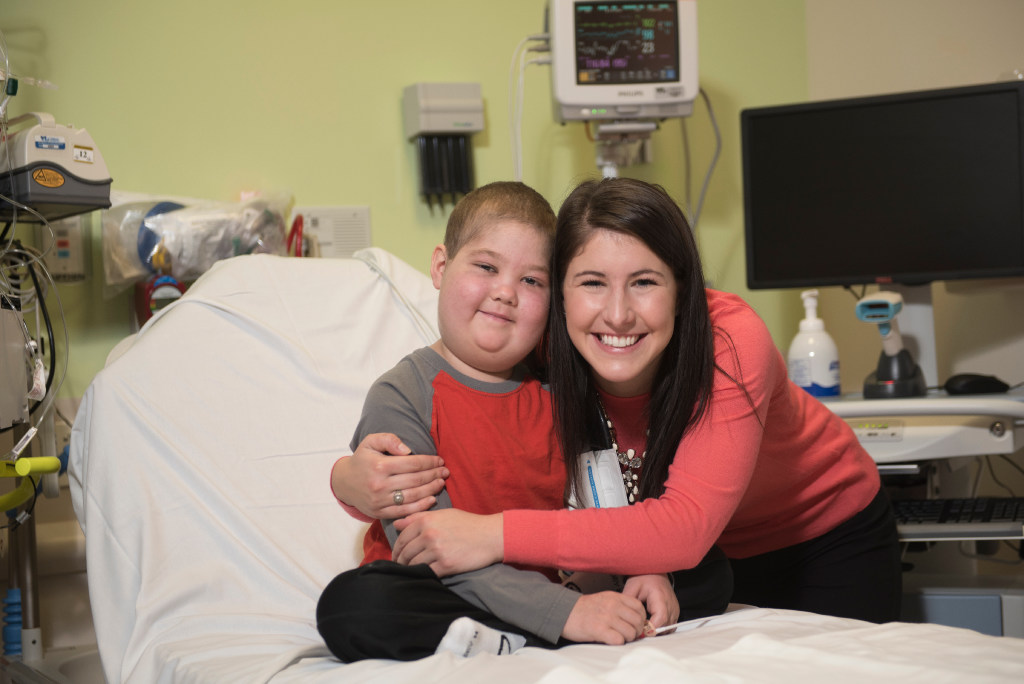Condition
Pediatric Neuroblastoma
What is neuroblastoma?
Neuroblastoma is a cancerous tumor that begins in nerve tissue of infants and very young children. The abnormal cells are often found in the nerve tissue that is present in the unborn baby and later develops into a detectable tumor. Neuroblastoma is rare in kids older than 10 years of age; however, it does occur occasionally in adults.
The tumor usually begins in the tissues of the adrenal gland found in the abdomen, but may also begin in nerve tissue in the neck, chest, or spinal cord. The adrenal glands are positioned on top of the kidneys. These glands secrete hormones and other important substances that are required for normal functions in the body.
Neuroblastoma cancer cells can spread (metastasize) quickly to other areas of the body (for example, lymph nodes, liver, lungs, bones, central nervous system and bone marrow). Approximately two-thirds of all children diagnosed with neuroblastoma will have some metastatic disease.
Frequently Asked Questions
How common is neuroblastoma?
In the U.S., approximately 700 children are diagnosed with neuroblastoma each year. It is often present at birth, but not detected until the tumor begins to grow and compress the surrounding organs. Most kids affected by neuroblastoma have been diagnosed before the age of 5. In rare cases, neuroblastoma can be detected before birth by a fetal ultrasound. It is the most common solid tumor cancer in infants.
What causes neuroblastoma?
The only risk factor that has been established for neuroblastoma is heredity, although the vast majority of neuroblastomas are not inherited. Recent research indicates that certain genetic variations double the risk of this disease. Also, having this particular variation increases the chance that a child will develop a more aggressive form of the disease.
The average age at diagnosis in genetically linked cases is younger than those cases that are not inherited. Cancer that presents in several different areas of the body at once is a sign that it may be a genetically inherited cancer.
What are the symptoms of neuroblastoma?
The following are the most common symptoms of neuroblastoma. However, each child may experience symptoms differently. The symptoms of neuroblastoma vary greatly depending on size, location and spread of the tumor. Symptoms may include:
- Abdominal mass either felt during an examination or seen as swollen abdomen
- Painless, bluish lumps may be seen under the skin in infants
- Trouble breathing due to tumors in the chest or abdomen
- Tumors in the face or head can cause swelling and bruising of the area around the eyes and uncontrolled eye movement or bulging eyes
- Compression of kidney or bladder by the tumor may cause changes in urination
- Bone marrow involvement may present as pain, fatigue, limping, paralysis or weakness
- Diarrhea may be present; diarrhea is caused by a substance produced by the tumor (vasoactive intestinal peptide or VIP)
- Fever
- High blood pressure and increased heart rate may occur depending on location of tumor and the organs the tumor compresses
The symptoms of neuroblastoma may resemble other conditions or medical problems. Always consult your child's doctor for a diagnosis.
How is neuroblastoma diagnosed?
In addition to a complete medical and physical examination, diagnostic procedures for neuroblastoma may include the following:
- Blood and urine tests. This includes a complete blood count, blood chemistries, kidney and liver function tests, and a 24-hour urinalysis test that detects substances secreted by the tumor.
- Neurological exam. This is a part of the physical exam used to check brain, spinal cord, and nerve function.
- Multiple imaging studies. These are done to evaluate primary tumor and determine extent/location of any metastases, including:
- Computed tomography scan (also called a CT or CAT scan). A diagnostic imaging procedure that uses a combination of X-rays and computer technology to produce horizontal, or axial, images (often called slices) of the body. A CT scan shows detailed images of any part of the body, including the bones, muscles, fat, and organs. CT scans are more detailed than general X-rays.
- Magnetic resonance imaging (MRI). A diagnostic procedure that uses a combination of large magnets, radiofrequencies, and a computer to produce detailed images of organs and structures within the body.
- X-ray. A diagnostic test that uses invisible electromagnetic energy beams to produce images of internal tissues, bones, and organs onto film.
- Ultrasound (also called sonography). A diagnostic imaging technique that uses high-frequency sound waves and a computer to create images of blood vessels, tissues, and organs. Ultrasounds are used to view internal organs as they function, and to assess blood flow through various vessels.
- Bone scans. Pictures or X-rays are taken of the bone after a radionucleotide (chemical with a small amount of a radioactive tag) has been injected that is absorbed by bone tissue. These are used to detect tumors and bone abnormalities.
- MIBG (metaiodobenzylguanidine) scan. A small amount of radioactive material called MIBG is injected into a vein and travels through the bloodstream. Neuroendocrine tumor cells take up the radioactive materials and can be seen on pictures. Scans may be taken over a few days.
- Bone marrow aspiration and/or biopsy. A procedure that involves taking a small amount of bone marrow fluid (aspiration) and/or solid bone marrow tissue (called a core biopsy), usually from the hip bones, to be examined for the number, size, and maturity of blood cells and/or abnormal cells.
- Biopsy of primary tumor and/or metastatic lesions
Diagnosing neuroblastoma also involves staging and classifying the disease that determines treatment options and prognosis. Staging is the process of determining whether cancer has spread and, if so, how far. There are various staging systems that can be used for neuroblastoma. Always consult your child's doctor for information on staging. One method of staging neuroblastoma is the following:
- Stage 1. This involves a tumor that does not cross the midline of the body, is completely resectable (removable by surgery), and has not spread to other areas of the body. The lymph nodes enclosed within the tumor may contain neuroblastoma cells, but lymph nodes outside the tumor are free of cancer.
- Stage 2A. This involves a tumor that does not cross the midline of the body, but is not completely resectable. This stage of tumor has not spread to other areas of the body, and lymph nodes on the same side as the tumor do not have tumor cells present.
- Stage 2B. This involves a tumor that may or may not be completely resectable, has not spread to other areas of the body, but lymph nodes on the same side of the tumor have tumor cells present. Lymph nodes on the opposite side of the tumor must be negative for tumor cells in this stage of disease.
- Stage 3. This involves a tumor that crosses the midline of the body and is not completely resectable; it may have spread to nearby lymph nodes. This stage also includes a tumor that does not cross the midline, but the lymph nodes that are nearby or on the opposite side also contain tumor cells. A tumor at this stage may also be found in the middle of the body, but is growing towards both sides and cannot be completely removed with surgery.
- Stage 4. This involves a tumor that has metastasized to distant lymph nodes, bone marrow, liver, skin, and/or other organs (except as defined in stage 4S).
- Stage 4S (also called "special" neuroblastoma). A child is younger than 12 months and has a tumor that may have metastasized (spread) to liver, skin, and/or bone marrow (includes minimal bone marrow involvement; more extensive bone marrow involvement should be classified as stage 4). The tumor is on 1 side of the body and is localized. It may have spread to the lymph nodes on the same side of the body.
Treatment for neuroblastoma
Specific treatment for neuroblastoma will be determined by your child's doctor based on:
-
Your child's age, overall health and medical history
-
Extent of the disease
-
Your child's tolerance for specific medications, procedures, or therapies
-
Expectations for the course of the disease
-
Your opinion or preference
Treatment may include (alone or in combination):
-
Surgery (for tumor and/or metastatic resection, and removal of lymph nodes involved)
-
Biologic therapy
-
Targeted therapy
-
Retinoid therapy
-
Supportive care (for the side effects of treatment)
-
Continuous follow-up care (to determine response to treatment, recurrent disease, and late effects of treatment)
Treatment options should be discussed with your child's doctor.
Long-term outlook for a child with neuroblastoma
Prognosis greatly depends on:
-
The extent of the disease.
-
The size and location of the tumor.
-
A presence or absence of metastasis.
-
The tumor's response to therapy.
-
The age and overall health of your child.
-
Your child's tolerance of specific medications, procedures or therapies.
-
New developments in treatment.
As with any cancer, prognosis and long-term survival can vary greatly from individual to individual. Prompt medical attention and aggressive therapy are important for the best prognosis. Continuous follow-up care is essential for a child diagnosed with neuroblastoma. Side effects of radiation and chemotherapy, as well as recurrence of the disease, can occur in survivors of neuroblastoma. New methods are continually being discovered to improve treatment and to decrease side effects.
Providers Who Treat Neuroblastoma

Evelio Perez-Albuerne, M.D., Ph.D.
- Blood and Marrow Transplant Specialist
Jul 22, 2024
Helping Maddie to Live Life to the FullestMaddie is a lively, creative teen who loves to act. Research at Children's National Hospital helps to ensure that her rare disease doesn"t upstage her big theater plans or her love of life.
Jun 27, 2024
Convenient Care for CharlotteWhen Charlotte was a toddler, a respiratory illness led to a diagnosis of a rare and dangerous immune deficiency called ICF syndrome. A bone marrow transplant at age 5 at Children’s National helped save her life.
May 20, 2024
Omid Conquers Fear with MusicOmid never liked going to the dentist. Dr. Aleger changed that with a little trust, and his favorite tunes.
Departments that Treat Neuroblastoma

Oncology
Our oncology (cancer) team provides personalized treatment plans for children with cancer, including access to clinical trials.

Autologous Blood and Marrow Transplantation Program
Our goal is to provide specialized therapy for children in an effort to restore their health using the most advanced and least invasive treatments possible.

Blood and Marrow Transplant
Our blood and bone marrow disease experts provide advanced transplant procedures for children and teenagers.

Solid Tumor Program
Our Solid Tumor Program has a dedicated team of sarcoma experts who specialize in the newest treatments and clinical trials.




